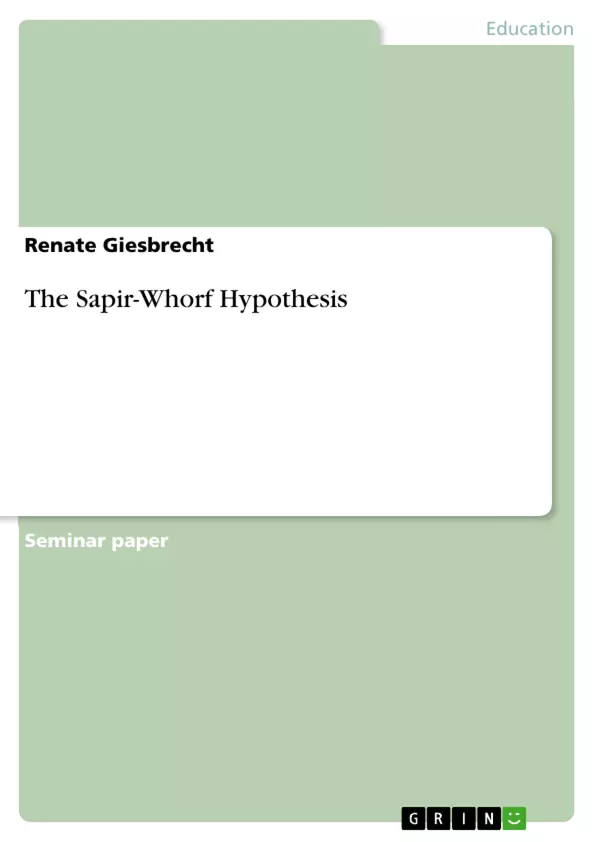The relationship between language, thought and reality has always been a fascinating subject for linguists and philosophers. Special attention was paid to it in the 20th century when Edward Sapir and Benjamin Lee Whorf published their opinions to this subject. Whorf forms the main part of the Sapir-Whorf hypothesis, because he was introduced by Sapir to his general approach to linguistics and then extended it in his beliefs. The term “Sapir-Whorf hypothesis” was first introduced by J.B. Carroll and states in general that a human’s language shapes his perception of reality or in other words, that the world as we know it is largely predetermined by the language of our culture (Jandt, 1995: 93). Occurring differences between languages do also represent the basic differences in the worldview of different cultures (Jandt, 1995: 101).
In this survey a general introduction to the hypothesis will be given by Sapir’s and Whorf’s definition of language. Furthermore the basic assumptions of the hypothesis will be conveyed. With the help of data taken from different languages these assumptions will be illustrated in detail. Finally also attention will be paid to criticism on the hypothesis.
Table of Contents
- INTRODUCTION
- LANGUAGE - A DEFINITION
- Sapir's Definition of Language
- Whorf's Definition of Language
- THE SAPIR-WHORF HYPOTHESIS
- ILLUSTRATION OF THE HYPOTHESIS ON THE BASIS OF GIVEN DATA
- CRITICISM ON THE HYPOTHESIS
- CONCLUSION
Objectives and Key Themes
This survey aims to provide a comprehensive overview of the Sapir-Whorf hypothesis, examining how language shapes our perception of reality. The paper delves into the definitions of language proposed by Sapir and Whorf, explores the core assumptions of the hypothesis, and illustrates these assumptions using data from different languages. Finally, the paper addresses criticism levied against the hypothesis.
- The relationship between language, thought, and reality
- The influence of language on cultural worldview
- The role of grammatical structures in shaping thought
- The impact of language on categorization and perception
- Critical analysis of the Sapir-Whorf hypothesis
Chapter Summaries
Introduction: The introduction sets the stage by highlighting the connection between language and human perception, drawing upon a Czech proverb. It introduces the Sapir-Whorf hypothesis, emphasizing the central role of language in shaping our understanding of the world. The introduction outlines the structure of the survey, previewing the key concepts and arguments to be explored.
Language - A Definition: This section delves into the definitions of language put forth by Edward Sapir and Benjamin Lee Whorf, highlighting the core assumptions underpinning the Sapir-Whorf hypothesis. It establishes the basis for understanding how language structures and influences thought.
Sapir's Definition of Language: This section presents Sapir's view on language as a system of symbols that communicates abstract thought. It emphasizes the shared nature of these symbols within a speech community and explores how language shapes cultural mentality and consciousness. Sapir's concept of language as a non-instinctive method of communication is also discussed, contrasting it with inherent biological functions such as walking.
Whorf's Definition of Language: This section focuses on Whorf's expansion of Sapir's ideas, particularly his belief that grammatical structures shape perception of reality. Whorf's concept of the "background linguistic system" as a shaper of ideas is introduced, and his observation that language influences how we dissect and categorize the world is emphasized.
Keywords
The primary keywords and focus topics of this text include language, thought, reality, perception, Sapir-Whorf hypothesis, linguistic structure, cultural worldview, grammatical mechanisms, categorization, and criticism.
- Citation du texte
- Renate Giesbrecht (Auteur), 2008, The Sapir-Whorf Hypothesis, Munich, GRIN Verlag, https://www.grin.com/document/135086



